about
おりんについて
about orin.


538年、おりんは仏教と共に仏具として、中国大陸から朝鮮半島を経て、日本へと伝わってきました。
はじめは、単に鳴り物としての存在でしたが、1100年頃から仏教が庶民の間に広がり盛んになっていくにつれて、おりんの音色がより心地良いものとなるようにと、僧侶と職人が意見交換し、試行錯誤をしながら、形や厚みを変え、日本独自の進化を繰り返してきました。
そして現在のおりんは、心を落ち着かせ、祈りに集中しやくするためのものとして仏事に欠かせないものになってます。
長い年月を経て今尚進化し続ける美しいおりんの音色、心の平穏や集中力を高める存在として、必要とする方に届き、広がっていくことを願っています。
In 538 AD, along with Buddhism, the bronze bell, known as "orin," was transmitted from the Chinese mainland to the Korean Peninsula and eventually to Japan.
Initially used simply as a musical instrument, around 1100 AD, as Buddhism spread among the common people, monks and craftsmen exchanged ideas and experimented to create a more pleasing tone for the orin, resulting in various changes in its shape and thickness, leading to Japan's unique evolution of the instrument.
Today, the orin is indispensable in Buddhist ceremonies, serving to calm the mind and focus prayers.
Over the years, we hope that the beautiful sound of the orin, will reach and spread to those who need it as a means of enhancing peace of mind and concentration.
シマタニ昇龍工房
Shimatani Syouryu Studio





北に日本海、南に雄大な立山連峰を臨む、富山県北西部に位置する高岡市は、今から約400年前、加賀(現在の石川県・富山県の一部)の前田家 二代当主 前田利長によって城下町として開かれました。
以降、高岡の町は、7人の鋳物職人が関西より招聘されたことにはじまる「高岡銅器」の産地としても発展し、鍋や釜、農具といった暮らしの道具から、戦のための武具、そして世の安寧を祈る仏具の生産を担い、今日まで各地の人々の営みを支えてきました。
昇龍は、江戸時代から続く鍛金技法によるおりん制作を本家より受け継ぎ、明治42年(1909年)、初代 島谷和吉のもと創業しました。
創業から110年の年月を経た現在、4代目 島谷好徳が先代や職人らと工房を守り、古きものを手当てしながら、新たな創造を手掛けています。
Located in the northwest of Toyama Prefecture, Takaoka City overlooks the majestic Tateyama mountain range to the south and the Sea of Japan to the north.
About 400 years ago, the city was established as a castle town by Maeda Toshinaga, the second lord of the Maeda family in Kaga (which includes present-day Ishikawa and parts of Toyama Prefecture). Since then, Takaoka has evolved into a prominent producer of "Takaoka copperware," beginning with the recruitment of seven skilled metalworkers from the Kansai region.
The town of Takaoka has played a crucial role in supporting the livelihoods of people from various regions. It has thrived as a center for the production of everyday items such as pots, kettles, and farming tools, as well as weaponry for warfare and religious artifacts praying for peace.
Syouryu, inheriting the art of ornamental metalworking from the Edo period, was founded under the guidance of the first generation, Wakichi Shimatani, in 1909 (Meiji 42). Now, after 110 years since its establishment, the fourth-generation owner, Yoshinori Shimatani, continues to uphold the traditions of his predecessors and craftsmen in the workshop.
While preserving the old, they also engage in new creative endeavors.
「昇龍」が放つ響きを受け継ぐ
Inheriting the resonances emitted by the "Syouryu".




「昇龍」のおりんは、百余りある金鎚・木槌から相応しい道具を用いて「真鍮を叩き、炎に当てる」を繰り返す鍛金技法によって形づくられ、最後に、おりんの縁を金鎚で叩いては聴き、叩いては聴き、調和のとれた‘うねり’へと導く調音によって、音が調えられ、唯一無二の音色が生まれます。
繊細な感性と確かな技量が求められるこうした技法は、絶え間のない手仕事と祈りのなか、歳月をかけて習得され、一子相伝によって受け継がれてきました。
今、時代の求めに応えるように、「昇龍」は仏具の枠を超え、更には文化風習の違いを超えて、世界各地の多様な人々の手元へと渡っています。
移りゆく人や社会のニーズに応じて、数々の工夫と創造が重ねられ、その技や意匠は進化を経ながら、森羅万象に通ずる奥義が守られています。
The "Syouryu's Orin" are crafted using a forging technique that involves repeatedly "hammering brass and exposing it to flames" using suitable tools chosen from over a hundred metal and wooden hammers. In the final stages, the edge of the "Oring" is struck with a hammer, creating an undulation of rhythmic striking and listening. Through the harmonious tuning achieved by this toning process, the sound is adjusted, giving birth to a unique and unparalleled tone.
This delicate and skill-demanding technique, carried out amidst continuous manual labor and prayers, is mastered over time and passed down through generations through direct transmission from parent to child.
Now, in response to the demands of the times, "Syouryu" transcends the framework of Buddhist instruments and even crosses cultural differences, reaching the hands of diverse people around the world.
Adapting to the changing needs of individuals and society, numerous innovations and creations have been accumulated. While the techniques and designs undergo evolution, the profound secrets that resonate with all things in universe are faithfully preserved.
制作工程
production process
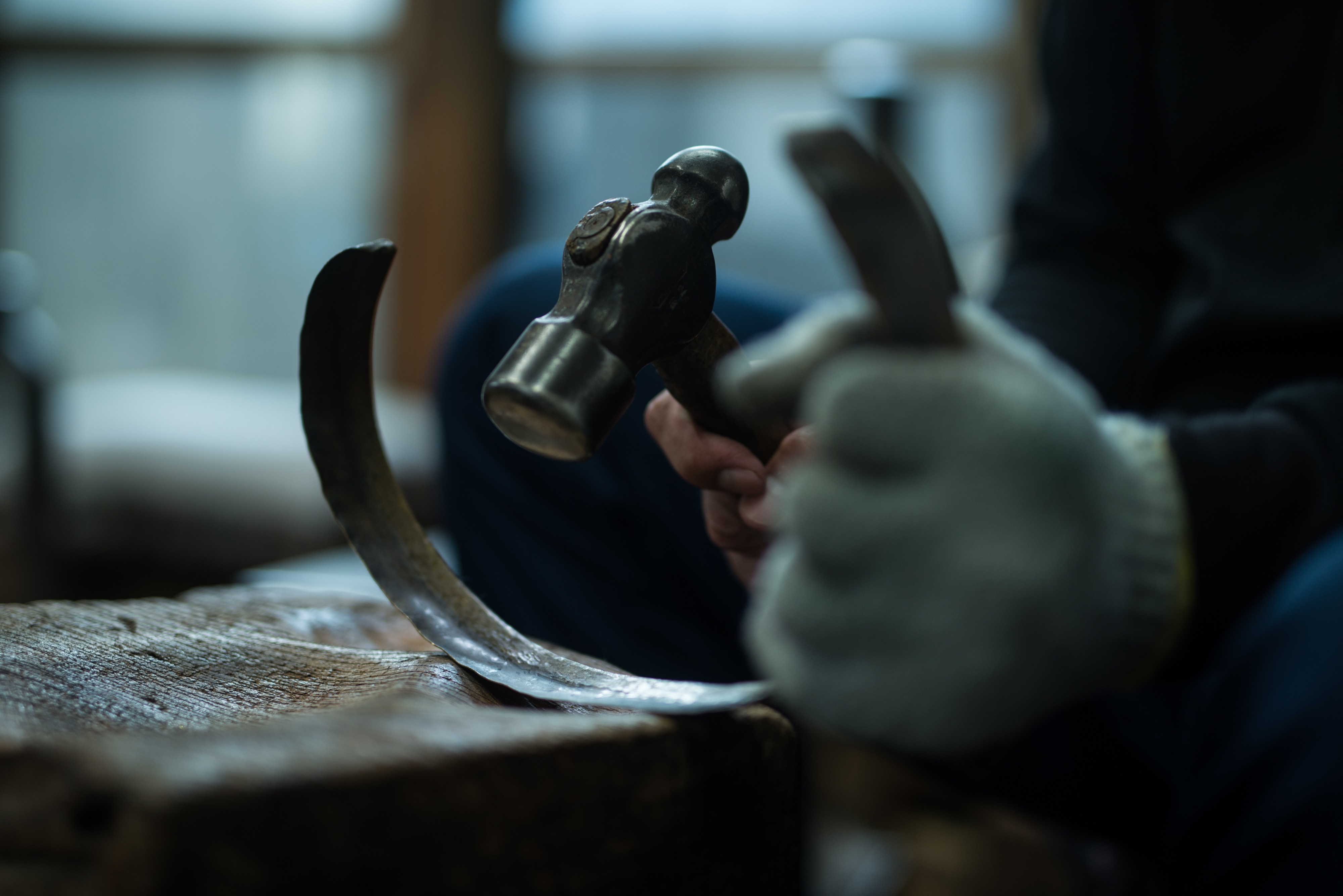
縁の加工
Edge processing
この作業は、おりんの音色の生命線である部分の仕事です。横からと上から両方金鎚で叩くことにより、金属密度を高め、柔らかく余韻の長い音色を引き出します。
This work is the work of the part that is the lifeline of the timbre of Kayako. By striking with a hammer from both the side and the top, the density of the metal is increased, bringing out a soft, long-lasting tone.
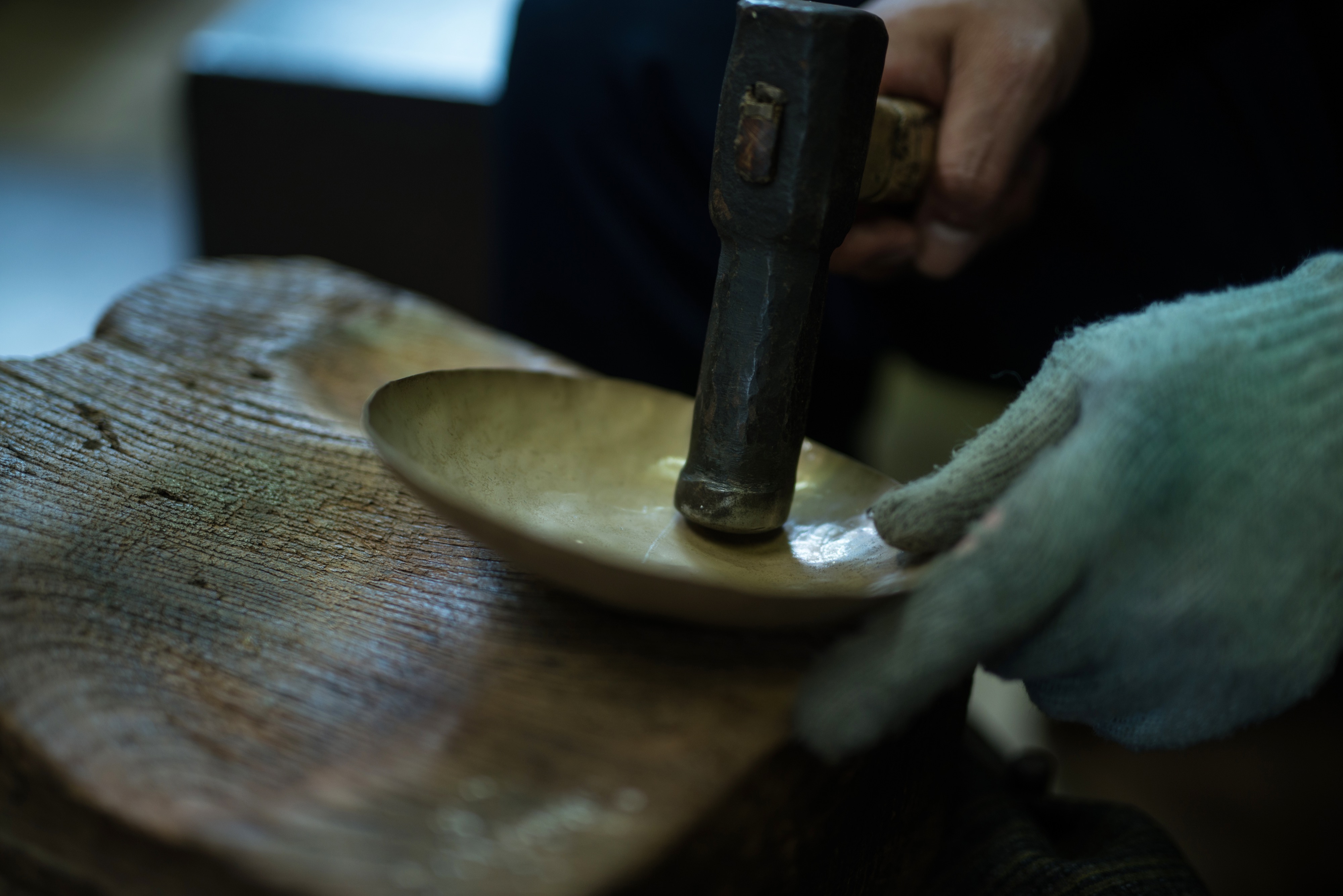
底絞り
squeese the bottom
窪んだ木の盤の上で、金鎚を使い、平らな板を徐々に絞っていきます。
Using a hammer on a dented wooden board, the flat board is gradually squeezed.
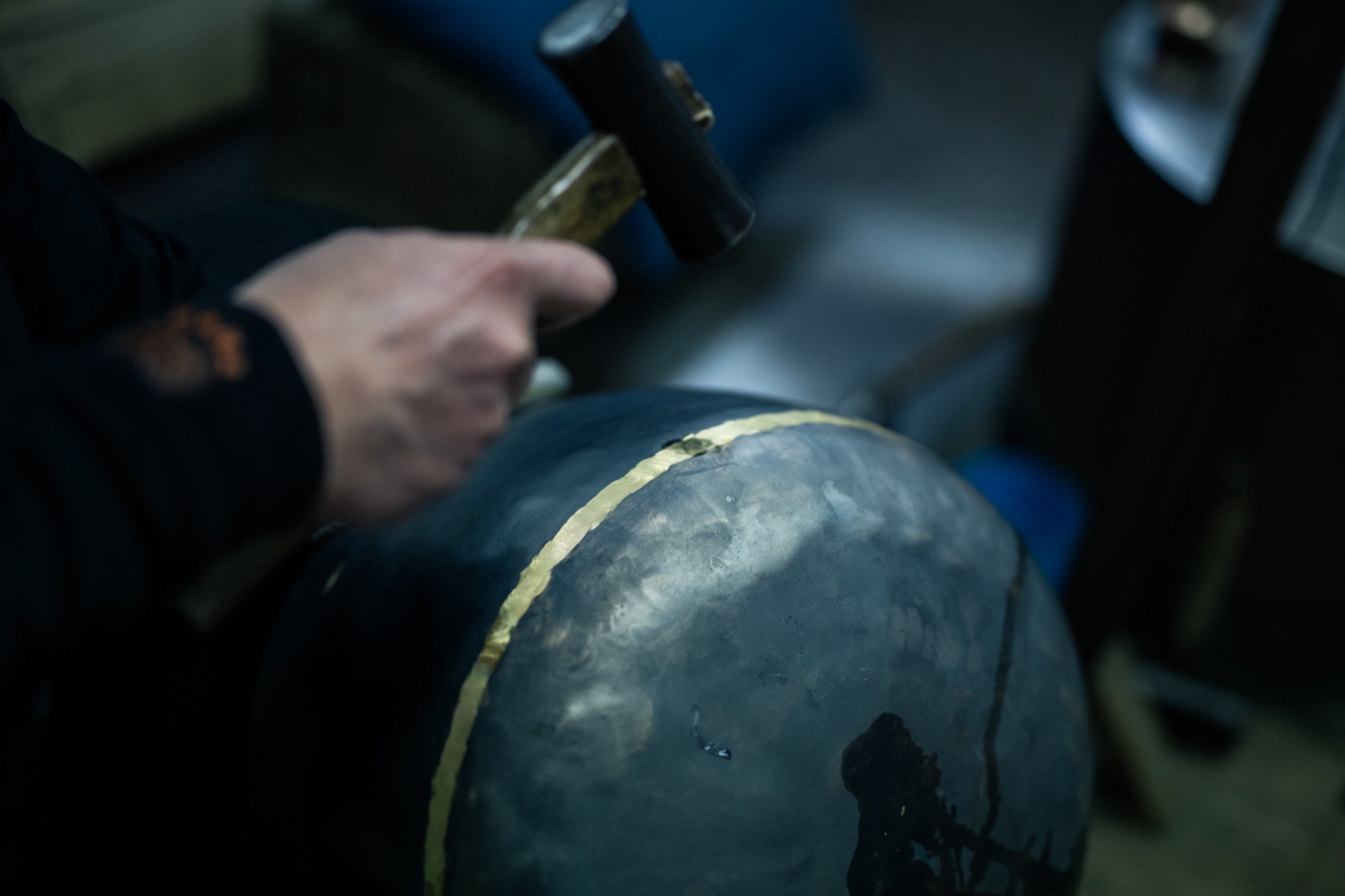
下仕事
preparation
上部の厚い部分と真ん中の部分と底の部分を、溶接でつないで、丸みの帯びた形に整えていきます。
Join the thick top part, the middle part, and the bottom part by welding to form a rounded shape.
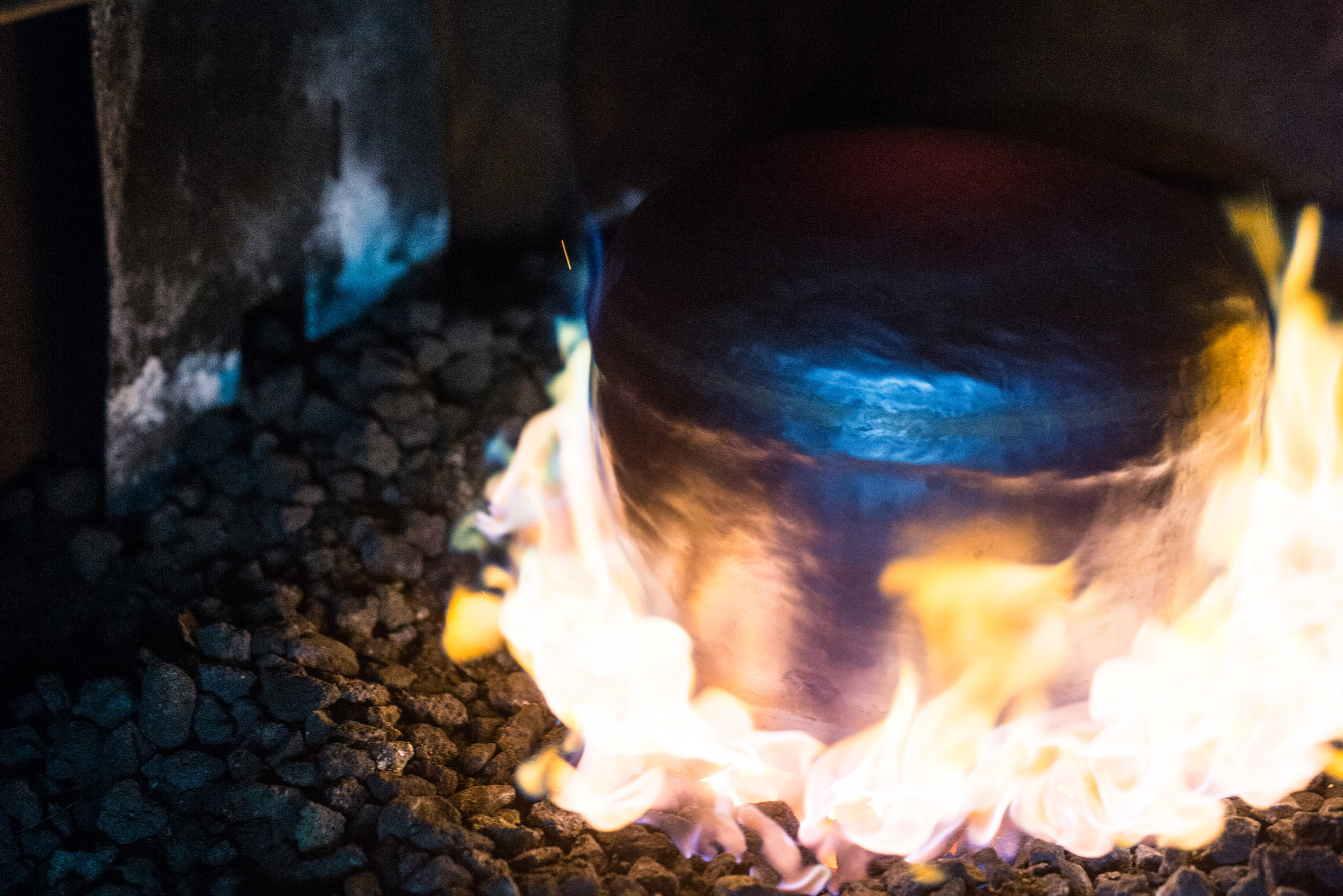
焼きなまし
Annealing
炭とコークスを合わせた炉で、おりんを真っ赤に焼き鈍します。おりんの素材である真鍮は、金鎚で叩くと硬くなります。そこで形を変えるため、焼き鈍します。
おりん作りは、叩いては、焼き鈍しを30 回以上繰り返しで、板状の真鍮を厚みを変えたり、形を丸く整えます。
In a furnace that combines charcoal and coke, "Orin" is annealed to a bright red color. The brass, which is the material of the Orin, hardens when struck with a hammer. It is then annealed to change its shape.
The making of "orin" involves repeating hammering and annealing more than 30 times to change the thickness of the plate-shaped brass and shape it into a round shape.
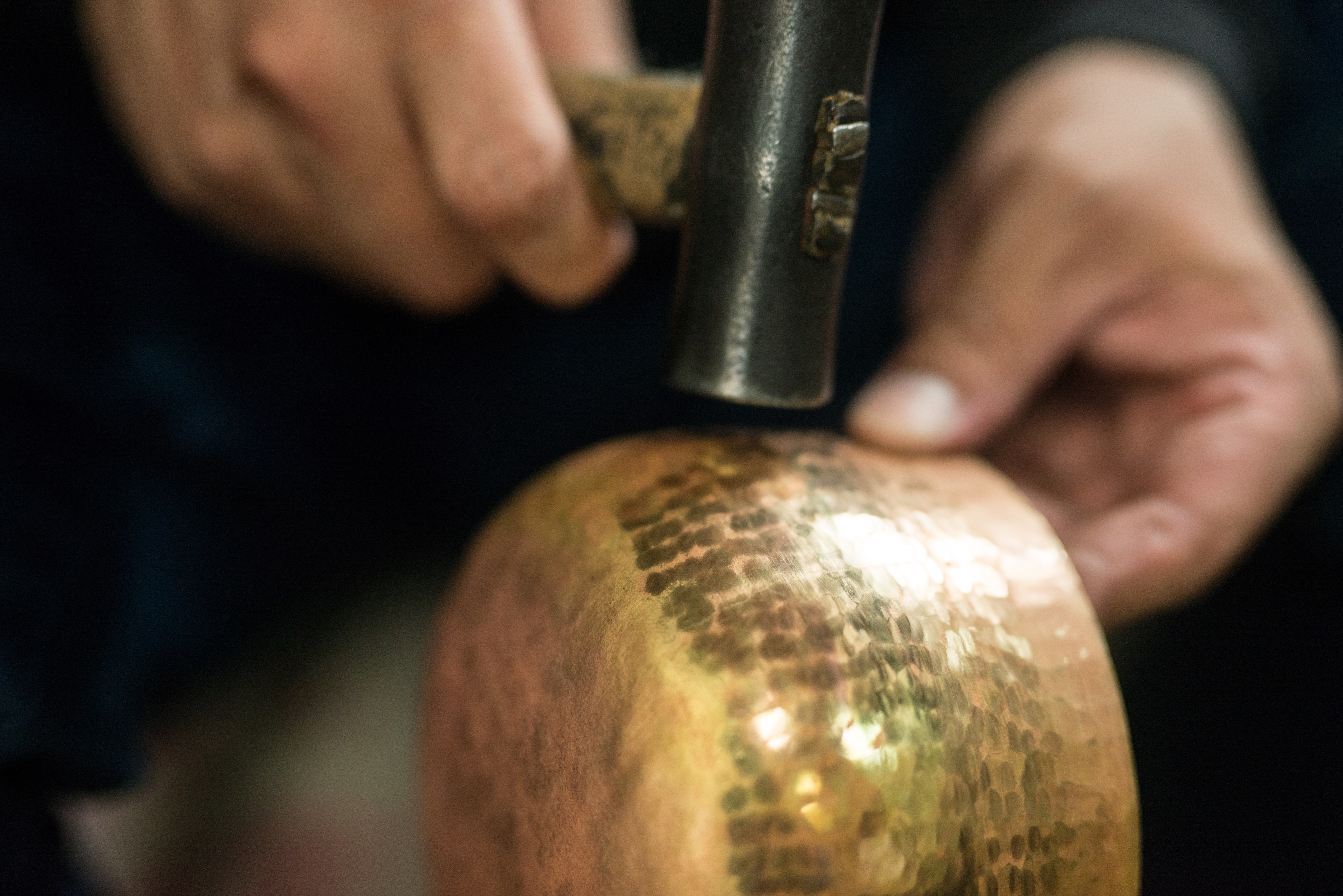
仕上げ
finishing touches
仕上げは、おりん全体を金鎚一つで下の金床に合わせて、隙間なく全て叩き上げていきます。
表面を凹凸がなくパーンっと張った状態にすることで、濁りの無い澄んだ音色のおりんに仕上げます。
For the finishing touches, the whole hammer is aligned with the bottom anvil with a single hammer, and the whole is hammered up without gaps.
By making the surface taut without any unevenness, it creates a clear tone with no turbidity.
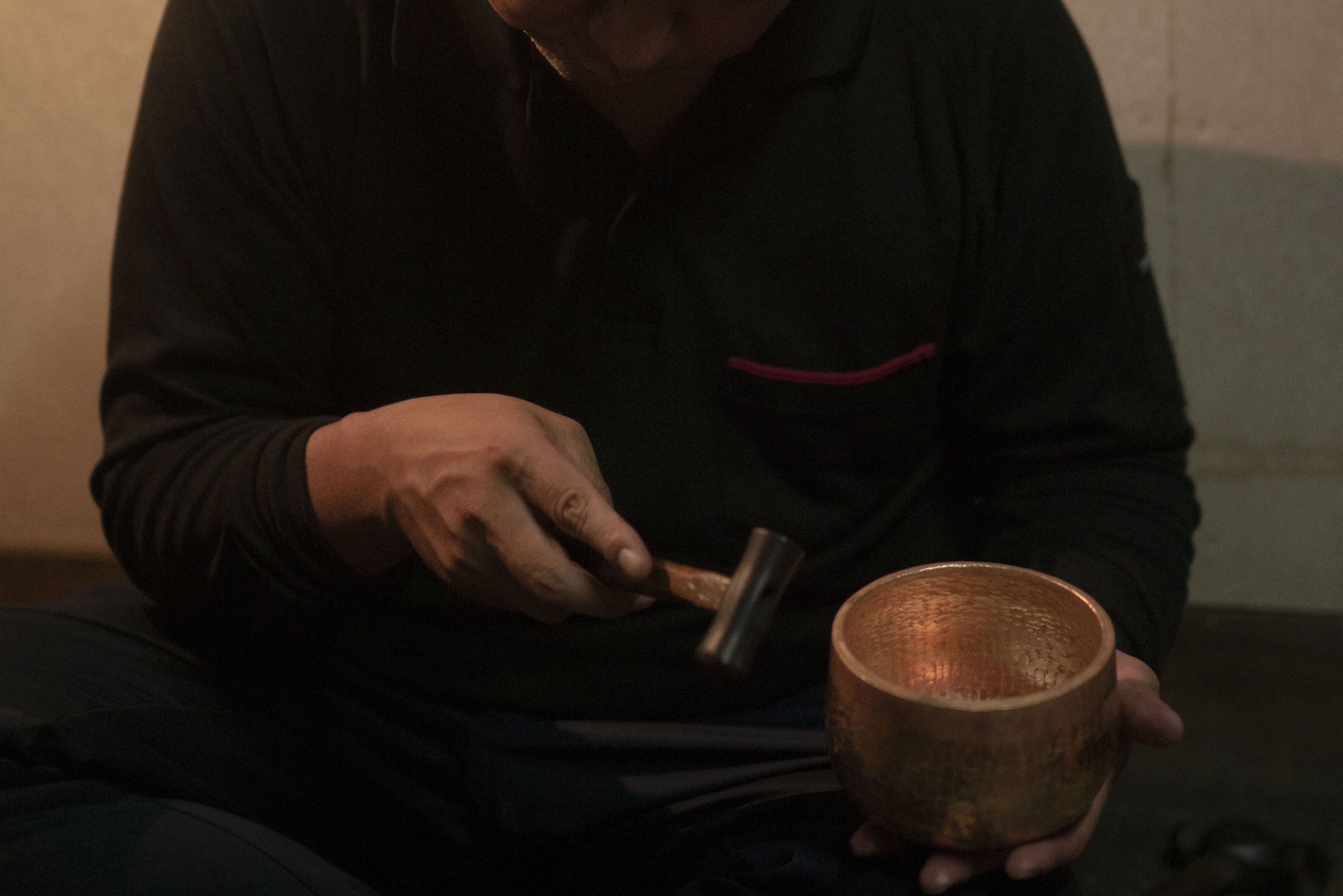
鳴り出し(調律)
tuning
調音する前のおりんは、うねりが早く心が落ち着かず、気忙しい音色です。
調音をするとおりんは、うねりゆったりとなり心が和み、自然と手を合わせたくなる音色になります。
The "orin" before tuning has a fast undulating, restless, and hectic tone. When you tune it, the tone becomes undulating and relaxing, and the tone naturally makes you want to put your hands together.
会社概要
company information
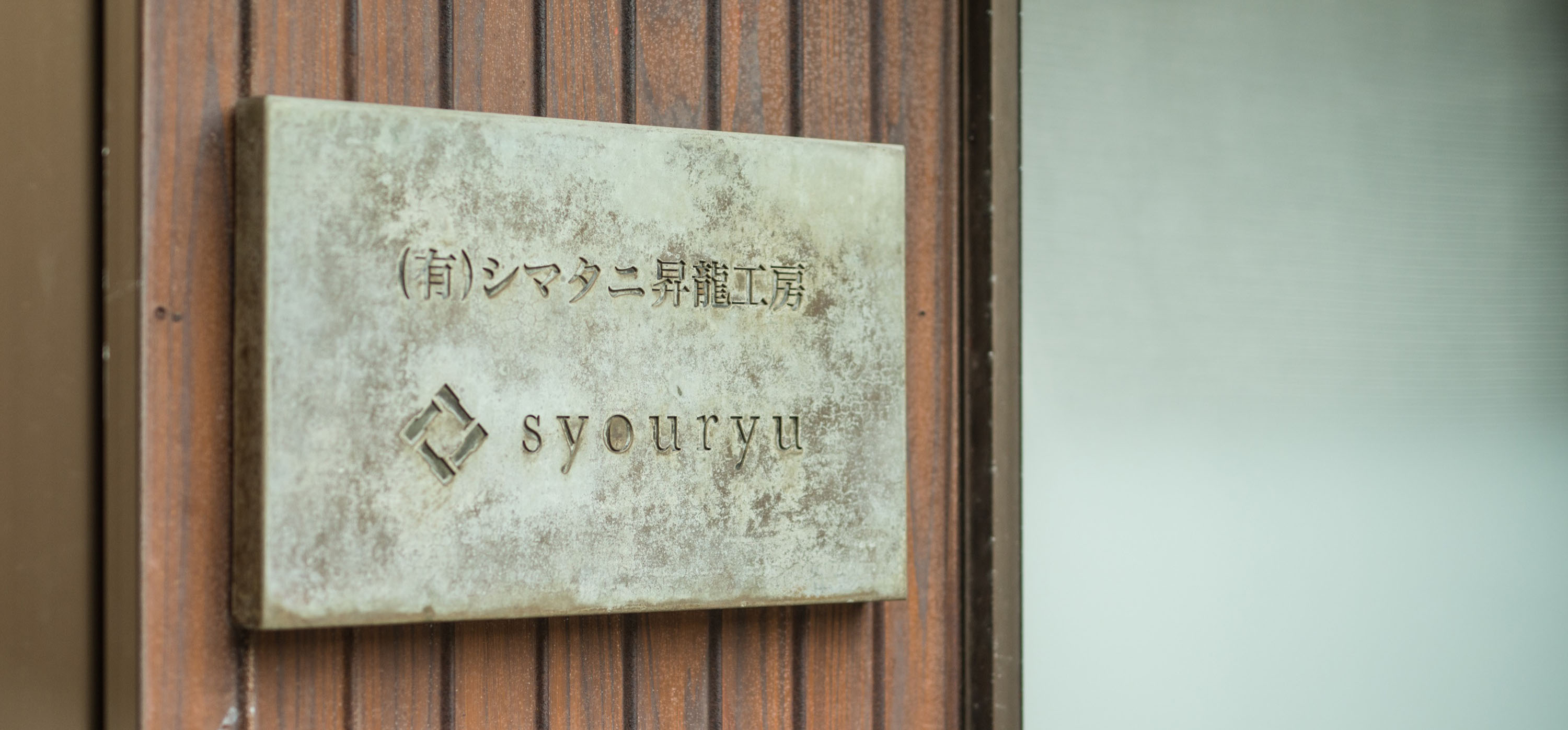
社名
有限会社シマタニ昇龍工房
company
Shimatani Syouryu Studio Co., Ltd.
創業
明治42年
founding
1909 (Meiji 42)
代表者
島谷 好徳
representative
shimatani yoshinori
住所
富山県高岡市千石町4-2
address
sengokucho 4-2, Takaoka city, Toyama, Japan
電話番号
0766-22-4727
tel
+81-766-22-4727
ファックス
0766-22-4717
fax
+81-766-22-4717
url
http://www.syouryu.co.jp
email
info@syouryu.co.jp
社名 / company
有限会社シマタニ昇龍工房
Shimatani Syouryu Koubou Co., Ltd.
Shimatani Syouryu Koubou Co., Ltd.
創業 / founding
明治42年
Meiji 42
Meiji 42
代表者 / representative
島谷 好徳
shimatani yoshinori
shimatani yoshinori
住所 / address
富山県高岡市千石町4-2
sengokucho 4-2, Takaoka city, Toyama, Japan
sengokucho 4-2, Takaoka city, Toyama, Japan
tel
0766-22-4727
fax
0766-22-4717
url
http://www.syouryu.co.jp
email
info@syouryu.co.jp
沿革
company history
初代昇龍 和吉
明治42年
父宗三郎のもと、おりんの製作に従事して初代昇龍を興す。
二代目昇龍 粂吉
昭和51年
経済産業大臣指定 伝統工芸品高岡銅器 伝統工芸士 認定
平成5年
日本伝統工芸士会 功労賞 受賞
平成8年
高岡市伝統産業技術保持者指定
平成11年
中部経済産業局長 表彰
平成12年
富山新聞 風雪賞 受賞
平成12年
勲七等青色桐葉賞 叙勲
平成13年
高岡市市民功労賞 受賞
三代目昇龍 粂一
平成6年
経済産業大臣指定 伝統工芸品高岡銅器 伝統工芸士 認定
平成16年
日本伝統工芸士会 功労賞 受賞
平成22年
高岡市伝統産業技術保持者指定
平成27年
卓越した技能者(現代の名工) 表彰
四代目昇龍 好徳
平成8年
経済産業大臣指定 伝統工芸品高岡銅器 伝統工芸士 認定
平成25年
鍛金の技術をいかした生活用品の自社ブランド「syouryu」を立ち上げる
http://syouryu.com
http://syouryu.com